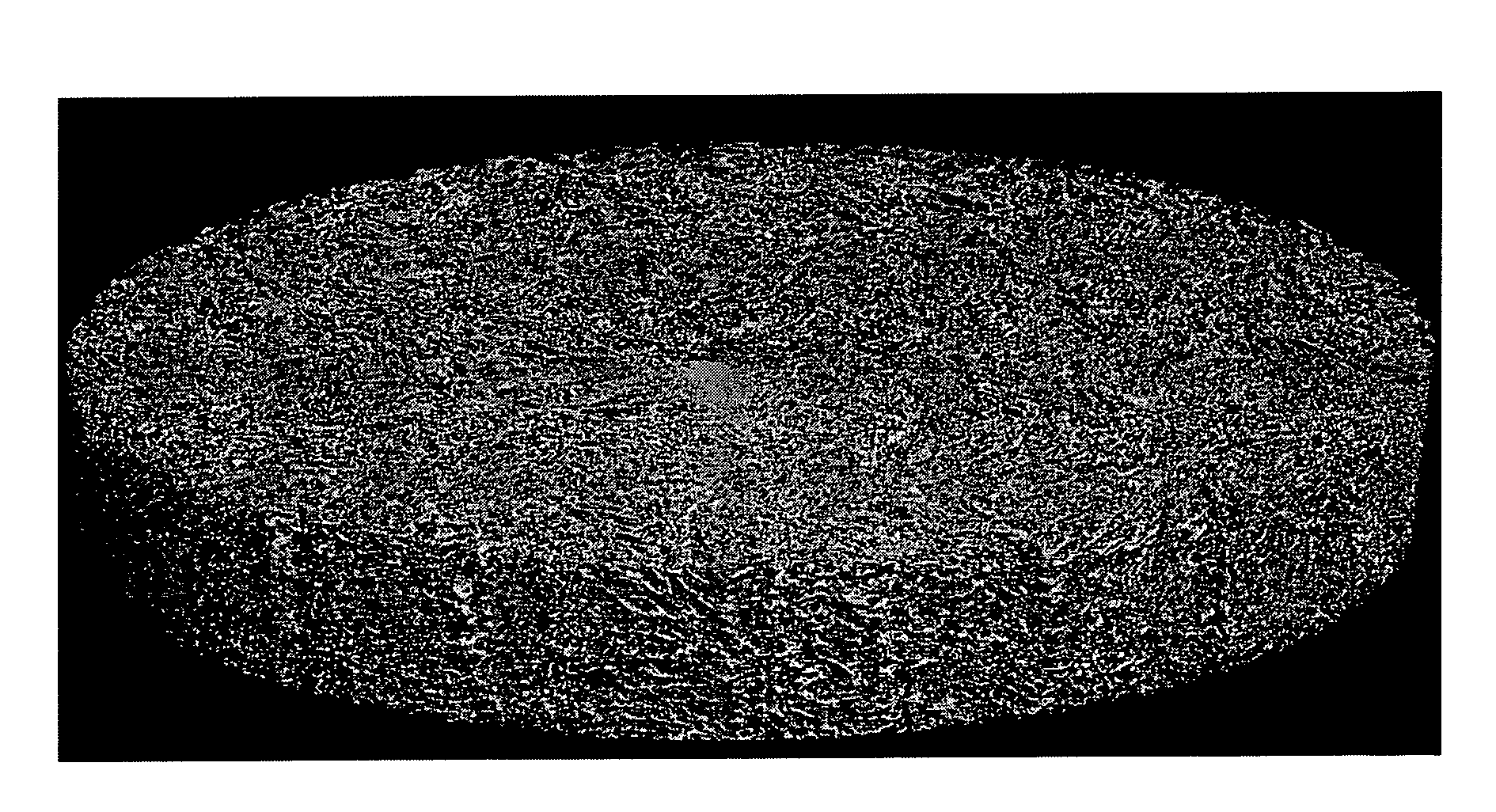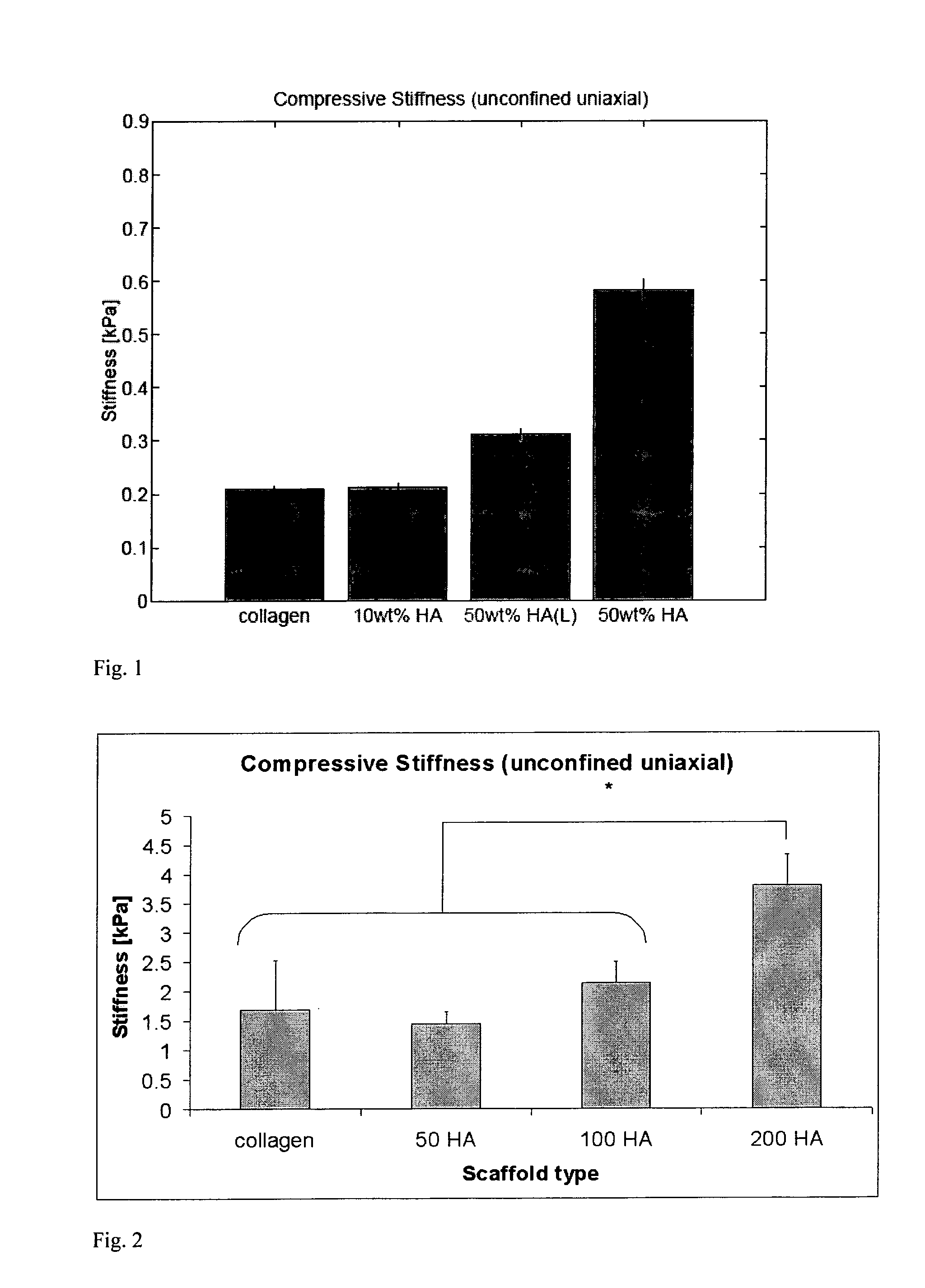Collagen/hydroxyapatite composite scaffold, and process for the production thereof
a technology of hydroxyapatite and composite scaffold, which is applied in the direction of prosthesis, inorganic non-active ingredients, peptide/protein ingredients, etc., can solve the problems of limited bone amount which can be removed, increased risk of infectious disease transmission, and additional invasive surgery, etc., to achieve excellent biocompatibility, promote cell adhesion, proliferation and extracellular matrix formation, and stabilize collagen fibres
- Summary
- Abstract
- Description
- Claims
- Application Information
AI Technical Summary
Benefits of technology
Problems solved by technology
Method used
Image
Examples
example 1
[0061]400 ml of a 0.05 M acetic acid solution (pH 3.05) was prepared using distilled, deionized water (1.16 ml glacial acetic acid was added to 398.84 ml of distilled, deionized water).
[0062]A WK1250 water cooling system (Lauda, Westbury, N.Y., USA) was used to cool a glass reaction vessel to a constant temperature of 4° C. for one hour. This reaction vessel was used to blend the scaffold constituents while maintaining the slurry at a constant temperature of 4° C. This prevented denaturation of the collagen fibres as a result of heat generation during the blending process.
[0063]1.8 gm of microfibrillar bovine tendon collagen (Collagen Matrix Inc., NJ, USA) was added to 320 ml of the 0.05 M acetic acid solution. This suspension was blended using an IKA Ultra Turrax T18 overhead blender (IKA Works Inc., Wilmington, N.C.) at 15,000 rpm for 90 minutes at 4° C. 40 ml of the acetic acid solution was mixed with hydroxyapatite (HA) powder (Biotal, UK), specifically 10% by weight of collagen...
example 2
[0067]400 ml of a 0.1 M acetic acid solution (pH 2.9) was prepared using distilled, deionised water (2.32 ml glacial acetic acid was added to 397.68 ml of distilled, deionized water). A WK1250 water cooling system (Lauda, Westbury, N.Y., USA) was used to cool a glass reaction vessel to a constant temperature of 4° C. for one hour. 1.8 gm of microfibrillar bovine tendon collagen (Collagen Matrix Inc., NJ, USA) was added to 320 ml of the 0.1 M acetic acid solution. This suspension was blended using an IKA Ultra Turrax T18 overhead blender (IKA Works Inc., Wilmington, N.C.) at 15,000 rpm for 90 minutes at 4° C.
[0068]40 ml of the acetic acid solution was mixed with hydroxyapatite (HA) powder (Biotal, UK), specifically 50% by weight of collagen (0.9 gm HA). A 10 ml aliquot of this acetic acid / HA solution was added to the collagen / acetic acid slurry in the cooled reaction vessel at 90 minutes. 10 ml aliquots (three in total) were added subsequently to the slurry every hour. After the fina...
example 3
[0072]400 ml of a 0.5 M acetic acid solution (pH 2.55) was prepared using distilled, deionised water (11.6 ml glacial acetic acid was added to 388.4 ml of distilled, deionized water). A WK1250 water cooling system (Lauda, Westbury, N.Y., USA) was used to cool a glass reaction vessel to a constant temperature of 4° C. for one hour. 1.8 gm of microfibrillar bovine tendon collagen (Collagen Matrix Inc., NJ, USA) was added to 320 ml of the 0.5 M acetic acid solution. This suspension was blended using an IKA Ultra Turrax T18 overhead blender (IKA Works Inc., Wilmington, N.C.) at 15,000 rpm for 90 minutes at 4° C.
[0073]40 ml of the acetic acid solution was mixed with hydroxyapatite (HA) powder (Biotal, UK), specifically 50%, 100%, and 200%, by weight of collagen (0.9, 1.8, and 3.6 gm HA). A 10 ml aliquot of this acetic acid / HA solution was added to the collagen / acetic acid slurry in the cooled reaction vessel at 90 minutes. 10 ml aliquots (three in total) were subsequently added to the sl...
PUM
| Property | Measurement | Unit |
|---|---|---|
| Temperature | aaaaa | aaaaa |
| Temperature | aaaaa | aaaaa |
| Fraction | aaaaa | aaaaa |
Abstract
Description
Claims
Application Information
 Login to View More
Login to View More - R&D
- Intellectual Property
- Life Sciences
- Materials
- Tech Scout
- Unparalleled Data Quality
- Higher Quality Content
- 60% Fewer Hallucinations
Browse by: Latest US Patents, China's latest patents, Technical Efficacy Thesaurus, Application Domain, Technology Topic, Popular Technical Reports.
© 2025 PatSnap. All rights reserved.Legal|Privacy policy|Modern Slavery Act Transparency Statement|Sitemap|About US| Contact US: help@patsnap.com



